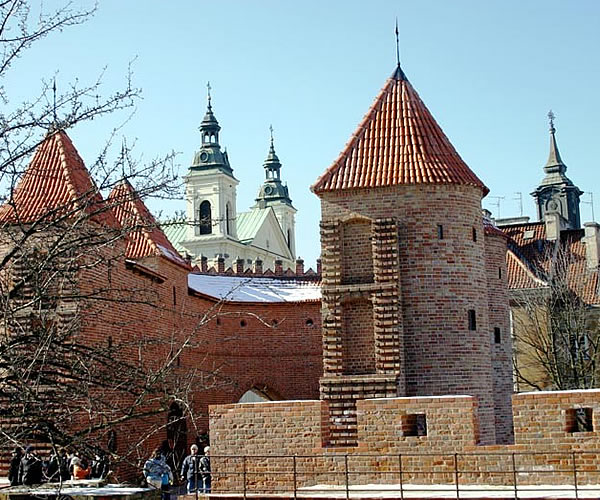
Much can be told about the history of Warsaw. Its past is a dramatic and a tragic story but reveal the biggest characteristic of the city - its indestructibility. Warsaw is like a phoenix that has risen repeatedly from the ashes of war. Having suffered fearful damage during Swedish and Prussian (wars) and being almost completely destroyed during World War II, the city is now again flourishing.
The spelling of Warsaw in Polish is Warszawa. It is also known as Varsovie (French), Warschau (German) and Varsovia (Spanish). The name means "owned by Warsz" and derives from a nobleman (12th/13th century) who owned a village located at the site of today's Mariensztat neighbourhood.
Warsaw was settled at the end of 13th century, when a new town of Mazovian Dukes was established on a high embankment of the Vistula River. Its location corresponds to that of the Royal Castle. In 1413 the capital of Mazovia was officially moved from Czersk to Warsaw. The city, due to its convenient location, experienced a period of rapid development and became the leading city of the entire state.
In 1596, following a fire at the Wawel Castle in Cracow, King Sigismund III Vasa moved his permanent residence, the royal court and the crown offices to the extended Warsaw castle. The city became the capital of the Polish-Lithuanian Commonwealth and at the same time of the Polish Crown. Consequently, the city knew another period of prosperity.
Warsaw was always part of the turbulent history of Poland. In the18th century it became an unquestionable centre of political, economical, commercial and industrial life of the country. In 1791 the Polish Parliament passed the Constitution (the first in Europe and the second in the world). But soon after, Poland was partitioned between Russia, Austria and Prussia and disappeared for 123 years from the maps of Europe. Despite the adverse political conditions, the Warsaw continued to develop and its industrial potential kept growing.
Warsaw became the capital of the newly independent Poland in 1918. In 1939 Germany invaded Poland and the World War II started. It brought the biggest tragedy in the history of the city. Uprising in the Jewish Ghetto in 1943 resulted in a total annihilation of this district populated by half a million people. The next year Warsaw again fought for its freedom - the Warsaw Uprising, lasting 63 days, was finally defeated and the city was given a death sentence. The population was expelled or deported to concentration camps. The Germans began the systematic destruction of the town. The cultural losses, including burned-down libraries, museums, collections, churches, palaces and the property of the inhabitants, were incalculable. Some 650.000 people died and 84 percent of the urban fabric was destroyed. The special Nazi detachments set on fire every house and a street after a street. The most significant buildings, such as the Royal Castle, were blown up. The intention was not to leave a single building standing.
In 1945 rebuilding of Warsaw began. The city like a phoenix has risen from the ashes of war. Following the World War II it lived over half a century under socialism but today Warsaw is again free and flourishing. The city is currently experiencing the biggest economic boom of its history and is again in its "golden age".
Update 17/04/2008
Keep more of your money when transferring funds overseas!

If you want to move money abroad, from Poland or to Poland for example, Fexco provides efficient and secure global bank to bank transfers and bespoke payment solutions for both business and personal clients.
Why Fexco
Fexco provides a secure international money transfer service online or by telephone with bank beating fx rates and low fees. Specialises in high-value transfers.
Main characteristics
Fexco will help you to keep your overseas money transfer costs to a minimum.
| Margin | 0.6% |
|---|---|
| Regulator | FCA |
| Fee | £10 < £5K or Free > £5k |
| Mini | £1K |
| Ccy | All (130 currencies, incl ‘exotics’) |
| Services | Repatriation of funds, Property, Regular payments, High Value payments, spot, online, telephone. |
Get an online quote today
When you are ready to make your transfer, John and his team will be available to help you with better rates and an unrivalled service to make sure your funds are delivered securely and speedily.
